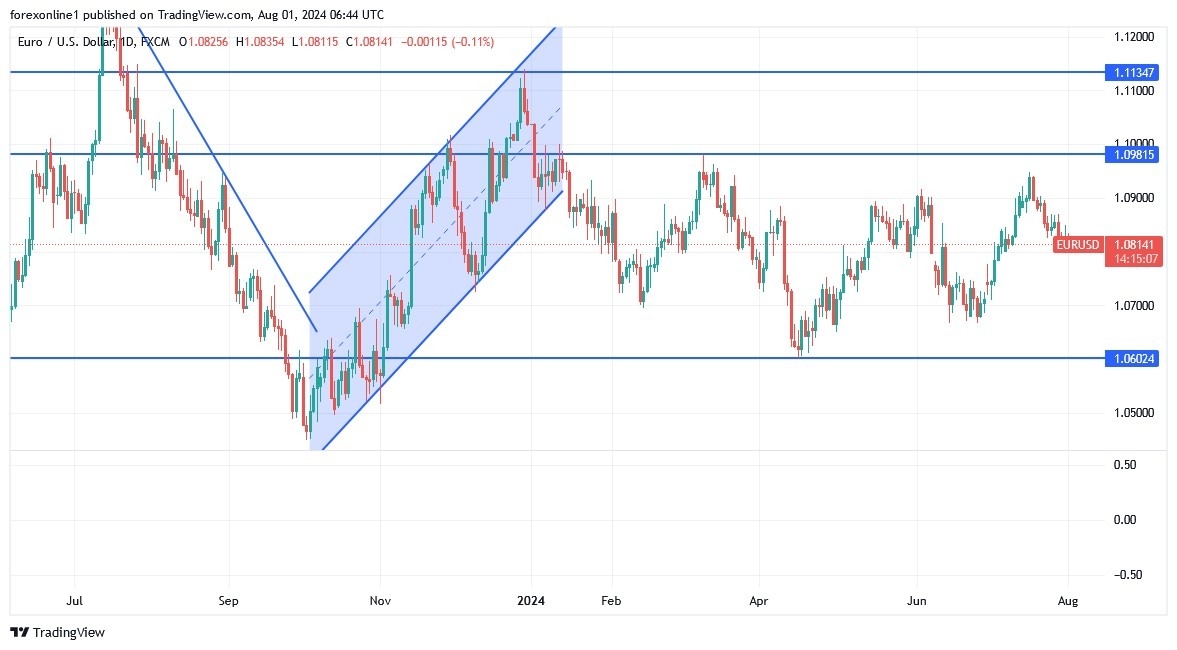- The euro hovered around $1.082, remaining below a four-month high of $1.094 touched on July 17, as traders digested key economic data and assessed the next move from the European Central Bank.
- Eurozone annual inflation unexpectedly accelerated to 2.6% in July, led by higher energy prices, but services inflation slowed for the first time in three months.
- Also, there is a mixed scenario across countries with prices rising faster in Germany, France and Italy but slowing in Spain.
Meanwhile, according to the economic calendar, preliminary estimates showed the eurozone economy expanded by a faster-than-expected 0.3% in the second quarter, led by growth in France, Italy and Spain. The German economy, on the other hand, contracted unexpectedly. The European Central Bank left interest rates on hold as expected in July, and President Lagarde said the September decision remained “wide open.” As a result, investors continue to price in at least two rate cuts by the European Central Bank this year, with the next cut in September.
On another note, affecting the EUR/USD pair and markets in general, the US Federal Reserve kept the federal funds rate at a 23-year high of 5.25%-5.50% for the eighth consecutive meeting in July 2024, in line with expectations. Policymakers noted that there had been some further progress toward the 2% inflation target, although it remains somewhat elevated. Recent indicators also suggest that economic activity has continued to expand at a solid pace. Job gains have slowed, and the unemployment rate has risen but remains low.
The US central bank judges that risk to achieving its employment and inflation goals continue to move toward a better balance. However, the Fed does not expect it to be appropriate to cut rates until it has greater confidence that inflation is moving sustainably toward 2%. During the regular press conference, Fed Chairman Powell said that a September rate cut could be on the table if inflation falls in line with expectations and that he could imagine scenarios where the Fed could cut rates several times this year or not at all.
According to electronic trading platforms, the German 10-year bond yield extended losses to 2.3%, hitting its lowest level in about four months, as traders continue to price in at least two rate cuts by the European Central Bank this year, with the first coming in September. Those bets remain despite an unexpected acceleration in eurozone headline inflation to 2.6% in July from 2.5%. However, services inflation eased for the first time in three months and data showed a mixed scenario across countries with prices rising faster in Germany, France and Italy but moderating in Spain.
Top Forex Brokers
EUR/USD Technical analysis and forecast:
According to the performance on the daily chart, the general trend of the Euro against the US Dollar EUR/USD is still bearish. As we mentioned before, breaking the support of 1.08 will remain important for more strength for the bears to move strongly downwards. Accordingly, the next strongest support levels will be 1.0720 and 1.0600, and from the last level, the technical indicators will move towards strong oversold levels. On the other hand, and over the same period of time, the psychological resistance of 1.1000 will remain the most important for the bulls to regain control of the trend. After being affected by the announcement of the Federal Reserve Bank and the inflation figures for the Eurozone, the next greatest interest will be in the announcement of the US jobs figures tomorrow, which will play a role in the direction of the Euro Dollar price closing, which is closest to the downside.
Ready to trade our EUR/USD Forex analysis? We’ve made a list of the best forex demo accounts worth trading with


